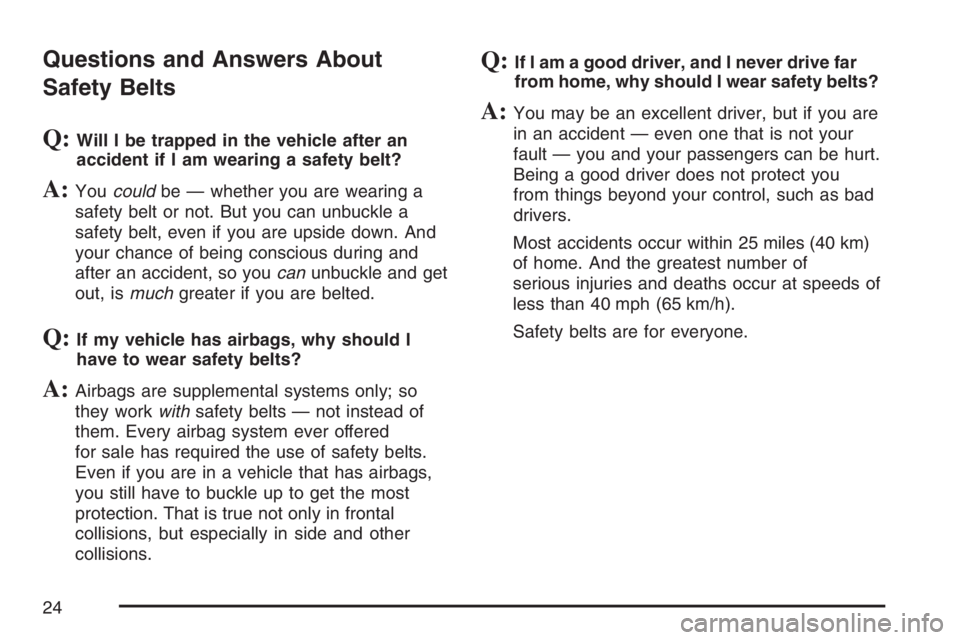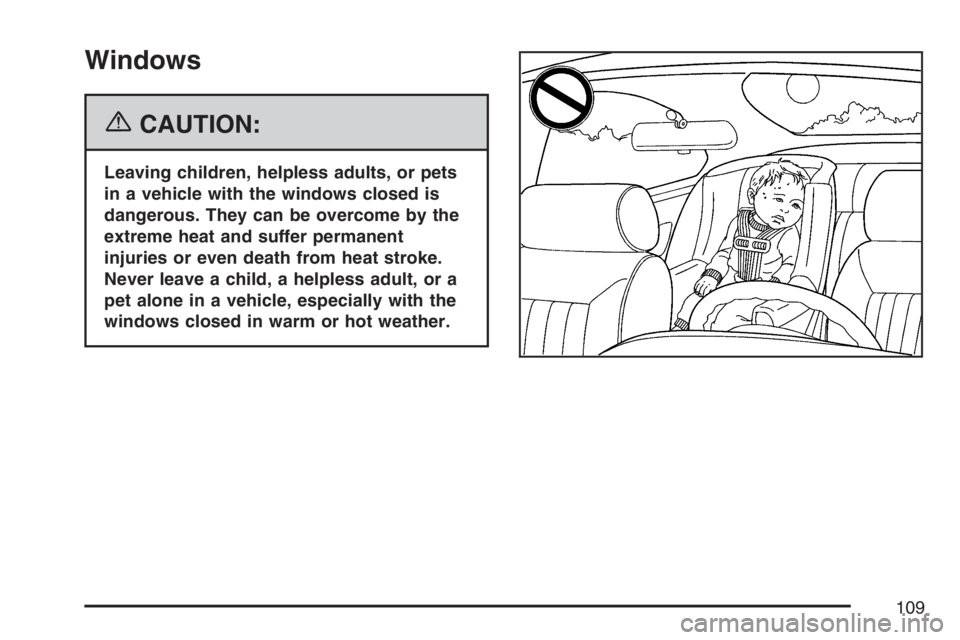2007 PONTIAC TORRENT ESP
[x] Cancel search: ESPPage 24 of 490

Questions and Answers About
Safety Belts
Q:Will I be trapped in the vehicle after an
accident if I am wearing a safety belt?
A:Youcouldbe — whether you are wearing a
safety belt or not. But you can unbuckle a
safety belt, even if you are upside down. And
your chance of being conscious during and
after an accident, so youcanunbuckle and get
out, ismuchgreater if you are belted.
Q:If my vehicle has airbags, why should I
have to wear safety belts?
A:Airbags are supplemental systems only; so
they workwithsafety belts — not instead of
them. Every airbag system ever offered
for sale has required the use of safety belts.
Even if you are in a vehicle that has airbags,
you still have to buckle up to get the most
protection. That is true not only in frontal
collisions, but especially in side and other
collisions.
Q:If I am a good driver, and I never drive far
from home, why should I wear safety belts?
A:You may be an excellent driver, but if you are
in an accident — even one that is not your
fault — you and your passengers can be hurt.
Being a good driver does not protect you
from things beyond your control, such as bad
drivers.
Most accidents occur within 25 miles (40 km)
of home. And the greatest number of
serious injuries and deaths occur at speeds of
less than 40 mph (65 km/h).
Safety belts are for everyone.
24
Page 104 of 490

Doors and Locks
Door Locks
{CAUTION:
Unlocked doors can be dangerous.
Passengers, especially children, can
easily open the doors and fall out of a
moving vehicle. When a door is
locked, the handle will not open it.
You increase the chance of being
thrown out of the vehicle in a crash if
the doors are not locked. So, wear
safety belts properly and lock the
doors whenever you drive.
CAUTION: (Continued)
CAUTION: (Continued)
Young children who get into unlocked
vehicles may be unable to get out.
A child can be overcome by extreme
heat and can suffer permanent injuries
or even death from heat stroke.
Always lock your vehicle whenever
you leave it.
Outsiders can easily enter through an
unlocked door when you slow down
or stop your vehicle. Locking your
doors can help prevent this from
happening.
There are a couple of ways to manually lock or
unlock your vehicle.
From the outside, use the key in the driver’s door.
From the inside, use the lock control on the door.
104
Page 109 of 490

Windows
{CAUTION:
Leaving children, helpless adults, or pets
in a vehicle with the windows closed is
dangerous. They can be overcome by the
extreme heat and suffer permanent
injuries or even death from heat stroke.
Never leave a child, a helpless adult, or a
pet alone in a vehicle, especially with the
windows closed in warm or hot weather.
109
Page 111 of 490

Visor Vanity Mirrors
Your vehicle has covered visor vanity mirrors on
both the driver’s and passenger’s side.
Theft-Deterrent Systems
Vehicle theft is big business, especially in some
cities. Although your vehicle has a number of
theft-deterrent features, we know that nothing we
put on it can make it impossible to steal.
Content Theft-Deterrent
To activate the theft-deterrent system:
1. Open the door.
2. Lock the door with the power door lock
switch or the remote keyless entry transmitter.
If you are using the remote keyless entry
transmitter, the door does not need to
be open.
3. Close all doors.Once armed, the alarm will go off if someone tries
to enter the vehicle without using the remote
keyless entry transmitter or a key or turns
the ignition on with an incorrect key. The horn will
sound and the turn signal lamps will �ash for
approximately two minutes.
When the alarm is armed, the trunk may be
opened with the remote keyless entry transmitter.
The power door lock switches are disabled
and the doors remain locked. You must use your
remote keyless entry transmitter or your key to
unlock the doors when the system is armed.Arming with the Power Lock Switch
The alarm system will arm when you use either
power lock switch to lock the doors while any door
or the trunk is open and the key is removed
from the ignition.
Arming with the Remote Keyless Entry
Transmitter
The alarm system will arm when you use your
remote keyless entry transmitter to lock the doors,
if the key is not in the ignition.
111
Page 117 of 490

Your vehicle has a Computer-Controlled
Cranking System. This feature assists in
starting the engine and protects components.
If the ignition key is turned to the START
position, and then released when the engine
begins cranking, the engine will continue
cranking for a few seconds or until the vehicle
starts. If the engine does not start and the
key is held in START for many seconds,
cranking will be stopped after 15 seconds to
prevent cranking motor damage. To prevent
gear damage, this system also prevents
cranking if the engine is already running.
Engine cranking can be stopped by turning the
ignition switch to the ACC or LOCK position.
Notice:Cranking the engine for long periods
of time, by returning the key to the START
position immediately after cranking has ended,
can overheat and damage the cranking
motor, and drain the battery. Wait at least
15 seconds between each try, to allow
the cranking motor to cool down.2. If the engine does not start after 5-10 seconds,
especially in very cold weather (below 0°F
or−18°C), it could be �ooded with too much
gasoline. Try pushing the accelerator
pedal all the way to the �oor and holding it
there as you hold the key in START for up to
a maximum of 15 seconds. Wait at least
15 seconds between each try, to allow the
cranking motor to cool down. When the engine
starts, let go of the key and accelerator.
If the vehicle starts brie�y but then stops
again, do the same thing. This clears the extra
gasoline from the engine. Do not race the
engine immediately after starting it. Operate
the engine and transaxle gently until the
oil warms up and lubricates all moving parts.
Notice:Your engine is designed to work with
the electronics in your vehicle. If you add
electrical parts or accessories, you could
change the way the engine operates. Before
adding electrical equipment, check with
your dealer. If you do not, your engine might
not perform properly. Any resulting damage
would not be covered by your vehicle’s
warranty.
117
Page 132 of 490

Automatic Dimming Mirror Operation
SeeAutomatic Dimming Rearview Mirror with
OnStar®and Compass on page 129for information
on Automatic Dimming Mirror Operation and
Compass Operation.
Outside Power Mirrors
The controls for the
power mirrors are
located on the
instrument panel.To adjust the mirrors, do the following:
1. Move the selector switch to the left or right to
choose the driver’s or passenger’s mirror.
2. Press the corresponding edges of the round
control pad to move each mirror to the
desired direction.
Adjust each outside mirror so that you can see a
little of your vehicle, and the area behind your
vehicle.
Both mirrors can manually be folded by pulling
them toward the vehicle. This feature may
be useful when going through a car wash or a
con�ned space. Push the mirrors away from the
vehicle, to the normal position, before driving.
132
Page 137 of 490

OnStar®service cannot work unless your vehicle
is in a place where OnStar®has an agreement
with a wireless service provider for service in that
area. OnStar
®service also cannot work unless
you are in a place where the wireless service
provider OnStar
®has hired for that area
has coverage, network capacity and reception
when the service is needed, and technology that
is compatible with the OnStar
®service. Not all
services are available everywhere, particularly in
remote or enclosed areas, or at all times.
OnStar
®service that involves location information
about your vehicle cannot work unless GPS
satellite signals are unobstructed and available in
that place as well.
Your vehicle must have a working electrical
system (including adequate battery power) for the
OnStar
®equipment to operate. There are other
problems OnStar®cannot control that may prevent
OnStar®from providing OnStar®service to you
at any particular time or place. Some examples are
damage to important parts of your vehicle in an
accident, hills, tall buildings, tunnels, weather
or wireless phone network congestion.
Your Responsibility
You may need to increase the volume of your
radio to hear the OnStar®advisor. If the light next
to the OnStar®buttons is red, this means that
your system is not functioning properly and should
be checked by a dealer. If the light appears
clear (no light is appearing), your OnStar
®
subscription has expired. You can always press
the OnStar®button to con�rm that your OnStar®
equipment is active.
Storage Areas
Glove Box
To open the glove box, pull the handle to the left
and pull the glove box door down until it stops
and is fully open.
Cupholder(s)
There are cupholders located at the front and rear
of the center console. To access, pull tray out.
There is also a cupholder located behind the shift
lever.
137
Page 160 of 490

Daytime Running Lamps (DRL)
Daytime Running Lamps (DRL) can make it easier
for others to see the front of your vehicle during the
day. DRL can be helpful in many different driving
conditions, but they can be especially helpful in the
short periods after dawn and before sunset. Fully
functional Daytime Running Lamps (DRL) are
required on all vehicles �rst sold in Canada.
The DRL system will make your low-beam
headlamps come on at a reduced brightness in
daylight when the following conditions are met:
The ignition is on.
The exterior lamp band is in the automatic
position.
The transaxle is not in PARK (P).
The light sensor determines it is daytime.
The parking brake is released.
When the DRL are on, the low-beam headlamps
will be on at a reduced brightness. The taillamps,
sidemarker and other lamps will not be on.
The instrument panel will not be lit up either.When you turn the exterior lamp band to the
headlamp position, your low-beam headlamps will
come on. The other lamps that come on with
your headlamps will also come on.
When you turn off the headlamps, the regular
lamps will go off, and your low-beam headlamps
will come on to the reduced brightness.
To idle your vehicle with the DRL off, move the
shift lever to PARK (P). The DRL will stay off until
you move the shift lever out of PARK (P).
As with any vehicle, you should turn on the regular
headlamp system when you need it.
Automatic Headlamp System
When it is dark enough outside and the exterior
lamps control is in the automatic position, the
headlamps will come on automatically. See
Headlamps on page 159.
Your vehicle has a light sensor located on top of
the instrument panel. Make sure it is not covered,
or the headlamps will be on when you do not
need them.
The system may also turn on the headlamps when
driving through a parking garage or tunnel.
160